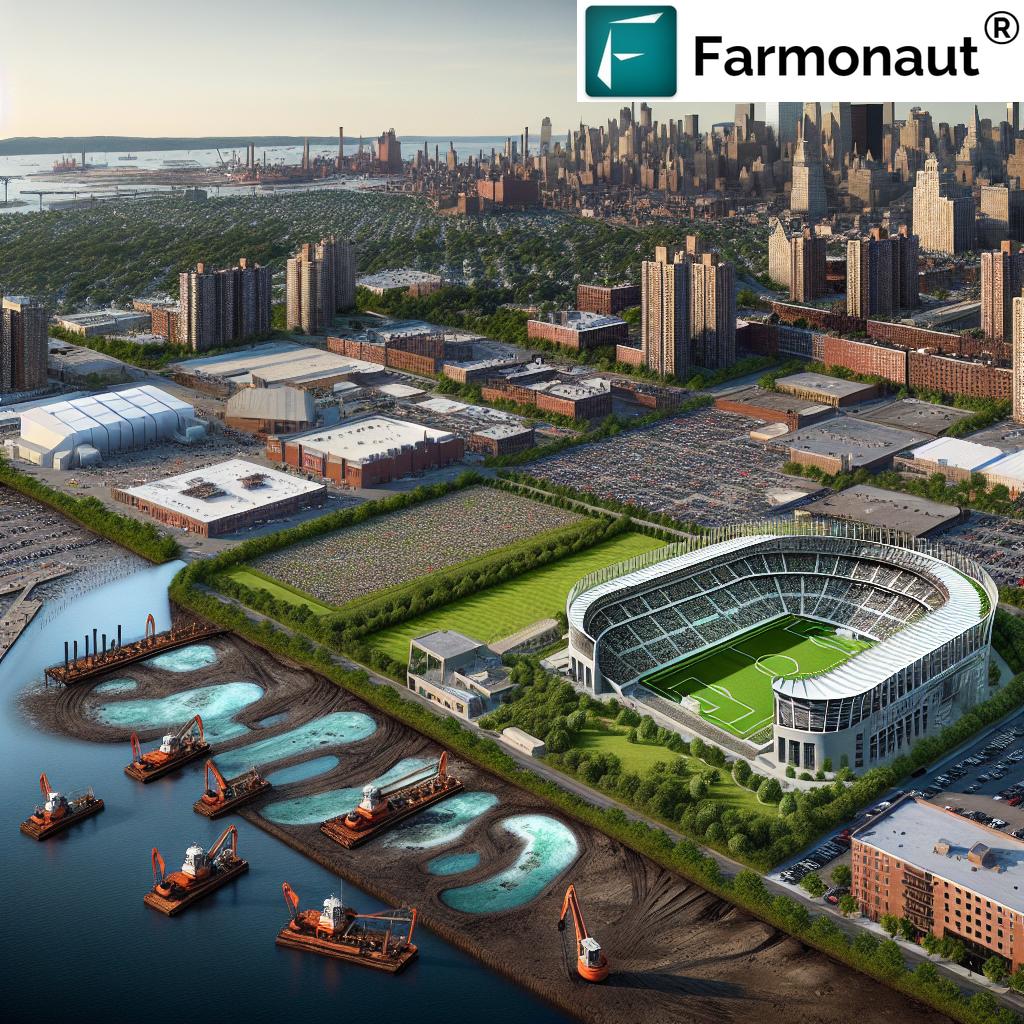Connecticut’s Minor League Soccer Stadium: Economic Impact and Funding Challenges in Bridgeport
“Connecticut’s proposed minor league soccer stadium project in Bridgeport involves an estimated $1 billion investment for urban redevelopment.”
As we delve into the ambitious plans for Connecticut’s minor league soccer stadium in Bridgeport, we find ourselves at the intersection of sports, economic development, and urban renewal. This project, with its potential to reshape the landscape of Bridgeport’s lower East Side, presents a compelling case study in the complexities of large-scale urban redevelopment initiatives.
The Vision for Bridgeport’s Soccer Stadium
The proposed Connecticut minor league soccer stadium is more than just a sports venue; it’s a cornerstone of a broader urban revitalization effort. With an estimated investment of over $1 billion, this project aims to create a multifaceted development that includes:
- A state-of-the-art soccer stadium
- 1,005 apartments
- A 260-room hotel
- At least 68,000 square feet of restaurant and retail space
This comprehensive approach to development speaks to a growing trend in urban planning, where sports venues serve as catalysts for broader economic growth and community revitalization.

Economic Impact: A Game-Changer for Bridgeport?
The economic potential of the Bridgeport stadium project has been a central talking point for its proponents. According to an economic impact study commissioned by Connecticut Sports Group and conducted by the Connecticut Center for Economic Analysis at the University of Connecticut, the project could have far-reaching benefits:
- A projected $2.2 billion economic impact from the minor league venue alone
- Creation of hundreds of new jobs
- Potential for long-term economic growth in the region
Fred Carstensen, director of the economic center, described the project as a “game-changer for Bridgeport and the state.” This assessment underscores the potential transformative effect of such large-scale developments on local economies.
Funding Challenges: The Public-Private Partnership Dilemma
“The initial state funding allocation for the Bridgeport stadium project was $16 million, with developers seeking additional financial aid.”
Despite the promising economic projections, the Bridgeport stadium project faces significant funding challenges. The delicate balance between public investment and private capital in sports venue construction is a topic of ongoing debate among lawmakers and economists.
- Initial state funding: $16 million ($8 million from the Community Investment Fund and $8 million from the Connecticut Department of Economic and Community Development)
- Developers seeking additional, unspecified state aid
- Total project budget estimated at $96.2 million as of earlier last year
The use of public funds for professional sports stadiums is a contentious issue. Senator Rob Sampson, R-Wolcott, has even submitted a bill to prohibit the use of state funds for such projects, arguing that “these private multi-million dollar ventures should not be put on the backs of taxpayers.”
Environmental Challenges: Cleaning Up the Past for a Brighter Future
One of the most significant hurdles facing the Connecticut minor league soccer stadium project is the environmental cleanup required at the proposed site. The land, which includes the former AGI rubber factory and the shuttered Winners Shoreline Star off-track betting facility, requires extensive remediation before construction can begin.
- The Connecticut Metropolitan Council of Governments is conducting an environmental analysis
- Federal funds of $196,000 have been allocated for the environmental assessment
- The extent of contamination and cleanup costs remain uncertain
Matthew Fulda, Executive Director of MetroCOG, stated that the environmental testing and reporting are expected to be completed by the end of February or sometime in March. This timeline is crucial for the project’s overall progress and could significantly impact the stadium’s construction costs and timeline.
Timeline Challenges: From Aggressive to Realistic
The Bridgeport stadium project’s timeline has already seen significant adjustments. Initially slated for a grand opening in early 2025, the project has been pushed back to spring 2026. However, even this revised timeline is subject to uncertainties:
- Environmental cleanup duration is still unknown
- State funding decisions may impact the construction timeline
- Connecticut Sports Group has indicated that Connecticut United’s debut in 2026 is not contingent on the stadium’s completion
These timeline shifts highlight the complexities involved in large-scale urban redevelopment projects, especially those involving sports venues and contaminated sites.
The Role of Public-Private Partnerships
Public-private partnerships play a crucial role in the development of sports venues like the proposed Connecticut minor league soccer stadium. These collaborations can bring together the resources and expertise of both sectors to create projects that benefit the community. However, they also raise questions about the appropriate use of public funds and the distribution of risks and rewards.
In the case of the Bridgeport stadium project, we see a complex interplay of private investment and public support:
- Connecticut Sports Group is spearheading the private investment
- State and local governments are providing funding and support for infrastructure and environmental cleanup
- The project’s success relies on ongoing negotiations between developers and public officials
As the project progresses, the balance between public and private interests will continue to be a critical factor in its success.

The Debate Over State Funding for Sports Stadiums
The use of state funds for professional sports stadiums is a topic of heated debate among lawmakers and economists. Proponents argue that these venues can spur economic growth and urban renewal, while critics contend that the benefits often fail to materialize and that public money could be better spent elsewhere.
In Connecticut, this debate is playing out in real-time:
- Governor Ned Lamont has expressed caution about further state investment in the stadium
- Some lawmakers are pushing for additional funding, citing potential economic benefits
- Others, like Senator Sampson, are seeking to prohibit the use of state funds for such projects entirely
As the legislative session progresses, the outcome of this debate will have significant implications for the Bridgeport stadium project and future sports venue developments in Connecticut.
The Potential for Urban Transformation
Beyond the economic projections and funding debates, the Connecticut minor league soccer stadium project represents a potential catalyst for urban transformation in Bridgeport. The development’s location on the lower East Side, an area that has long struggled with economic challenges, could bring new life and opportunities to the neighborhood.
Key aspects of this transformative potential include:
- Job creation, both during construction and in long-term stadium operations
- Increased foot traffic and economic activity in the surrounding area
- Potential for additional development and investment in the neighborhood
- Improved infrastructure and public spaces
However, it’s important to note that the success of such transformative projects often depends on careful planning and community engagement to ensure that the benefits are equitably distributed and that existing residents are not displaced.
Comparative Analysis: Sports Stadiums as Economic Drivers
To better understand the potential impact of the Connecticut minor league soccer stadium, it’s useful to examine similar projects in other cities. While each situation is unique, these comparisons can provide valuable insights into the challenges and opportunities associated with sports venue development.
| Aspect | Projected Benefits | Funding Challenges | Timeline |
|---|---|---|---|
| Economic Impact | $2.2 billion (minor league venue) | Securing additional state funding | Original: Early 2025 Current: Spring 2026 |
| Job Creation | Hundreds of new jobs | Environmental cleanup costs | Cleanup: End of Feb/March 2025 |
| Regional Growth | Long-term economic growth | $96.2 million initial budget | Construction start: TBD |
| Urban Renewal | Transformation of lower East Side | $16 million initial state allocation | Stadium completion: Spring 2026 (tentative) |
This comparative analysis helps contextualize the Bridgeport project within the broader landscape of sports venue development and urban renewal initiatives.
The Role of Technology in Modern Stadium Development
While the Connecticut minor league soccer stadium project focuses primarily on physical infrastructure, it’s worth noting the increasing role of technology in modern sports venues. From advanced turf management systems to state-of-the-art spectator experiences, technology is reshaping how stadiums are built and operated.
In the agricultural sector, companies like Farmonaut are leveraging satellite technology and AI to revolutionize farm management. While not directly related to stadium construction, these innovations in agricultural technology demonstrate the potential for cross-industry applications in large-scale development projects.
Environmental Sustainability in Stadium Design
As environmental concerns become increasingly prominent in urban development, the Connecticut minor league soccer stadium project has an opportunity to incorporate sustainable design principles. This could include:
- Energy-efficient systems and renewable energy sources
- Water conservation measures
- Use of recycled and sustainable materials in construction
- Green spaces and stormwater management systems
By prioritizing sustainability, the stadium could not only reduce its environmental impact but also serve as a model for future development projects in Connecticut and beyond.
Community Engagement and Stakeholder Involvement
The success of the Connecticut minor league soccer stadium project will depend not only on financial and technical considerations but also on community support and stakeholder engagement. Key aspects of this process include:
- Transparent communication with local residents and businesses
- Incorporation of community feedback into project plans
- Partnerships with local organizations and institutions
- Workforce development programs to ensure local job creation
By actively involving the community in the development process, the project can build support and ensure that its benefits are widely shared.
The Future of Minor League Sports in Connecticut
The proposed Connecticut minor league soccer stadium represents more than just a single venue; it’s a statement about the future of sports in the state. As minor league teams gain popularity and financial viability, they offer opportunities for cities like Bridgeport to participate in the sports industry without the massive investments required for major league franchises.
This trend could lead to:
- Increased sports tourism in Connecticut
- Development of local talent pipelines for professional sports
- Enhanced community pride and identity
- New revenue streams for local businesses
As the project progresses, it will be interesting to see how it shapes the broader landscape of sports and entertainment in Connecticut.
Conclusion: A Complex Project with Far-Reaching Implications
The Connecticut minor league soccer stadium project in Bridgeport stands as a testament to the complexities of modern urban development. It encompasses a wide range of issues, from economic development and environmental remediation to public-private partnerships and community engagement.
As the project moves forward, its success will depend on careful navigation of these challenges and effective collaboration among all stakeholders. The potential benefits are significant, but so are the risks and obstacles that must be overcome.
Ultimately, the Bridgeport stadium project offers valuable lessons for urban planners, policymakers, and developers across the country. Its progress will be closely watched not only by Connecticut residents but by anyone interested in the intersection of sports, economic development, and urban renewal.
FAQ Section
- Q: What is the total estimated investment for the Connecticut minor league soccer stadium project?
A: The project involves an estimated $1 billion investment for urban redevelopment, including the stadium, housing, hotel, and retail spaces. - Q: How much state funding has been allocated to the project so far?
A: The initial state funding allocation was $16 million, with $8 million from the Community Investment Fund and $8 million from the Connecticut Department of Economic and Community Development. - Q: What is the projected economic impact of the minor league venue?
A: According to the economic impact study, the minor league venue alone is projected to have a $2.2 billion economic impact. - Q: When is the stadium expected to be completed?
A: The current timeline targets spring 2026 for stadium completion, though this is subject to change based on various factors. - Q: What are the main challenges facing the project?
A: Key challenges include environmental cleanup of the contaminated site, securing additional state funding, and navigating the debate over public investment in sports stadiums.
Earn With Farmonaut: Affiliate Program
Earn 20% recurring commission with Farmonaut’s affiliate program by sharing your promo code and helping farmers save 10%. Onboard 10 Elite farmers monthly to earn a minimum of $148,000 annually—start now and grow your income!



















